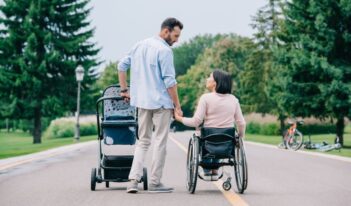
Scholar proposes regulatory solutions to protect disabled individuals’ reproductive autonomy.
Soon after Cristina Nuñez learned that she was pregnant, her doctor informed her that her disabling medical conditions would prevent her from safely carrying the pregnancy to term. Cristina’s doctor, however, was unsure whether Cristina qualified for Texas’s narrow abortion exception.
While her doctor sought the hospital’s approval to perform an abortion, Cristina underwent increased dialysis treatments and surgeries to address pregnancy complications that worsened her existing medical conditions. She waited one month to receive an abortion after requesting one.
This year, the Texas Supreme Court declined to hold that Nuñez and other women in similar positions can challenge the state’s abortion laws because the laws only target providers, not the person seeking an abortion.
The restriction of disabled people’s reproductive health choices is not new, argues Robyn M. Powell, a professor at Stetson University College of Law, in a recent article. The U.S. Supreme Court’s 1927 decision in Buck v. Bell exemplifies the dangers of historical notions that disabled people cannot make their own reproductive choices, Powell notes.
Carrie Buck was a seventeen-year-old girl who lived in foster care. She became pregnant after being sexually assaulted by a relative of her foster parents. Likely viewing her pregnancy as evidence of “promiscuity,” Carrie’s foster parents claimed that she was “feeble minded” and institutionalized her. After she gave birth to a daughter—who Carrie’s foster parents adopted—the state sought to invoke the Virginia Eugenical Sterilization Act to sterilize Carrie against her will.
Carrie challenged the law, but the Supreme Court upheld it as a valid protection of the public welfare. In this decision, Justice Oliver Holmes infamously declared that “three generations of imbeciles are enough.”
Powell contends that the Supreme Court’s failure to overturn such laws gave legitimacy to eugenic beliefs and led to the involuntary sterilization of 70,000 disabled people.
Almost 100 years after the Buck decision, Powell explains that disabled people’s reproductive autonomy remains restricted. She warns that the U.S. Supreme Court’s decision in Dobbs v. Jackson Women’s Health Organization will worsen existing health disparities. Powell highlights multiple barriers that disabled people face in attempting to access reproductive health care. For example, knowledge gaps often exist in physicians’ preparedness and training to provide reproductive care to disabled individuals. Powell contends that these gaps restrict disabled individuals’ ability to receive adequate care.
Powell notes that disabled people are 40 percent more likely to experience unintended pregnancy and are significantly less likely to use contraception than people without disabilities. Limited transportation options and a lack of accessibility features at doctor’s offices also contribute to this disparity, Powell adds.
Furthermore, Powell explains that many disabled people cannot afford abortion care. People with disabilities are more likely to rely on Medicaid and are twice as likely to live in poverty as people without disabilities. The Hyde Amendment prohibits the use of federal Medicaid funds to cover most abortions. Although states can choose to fund such coverage, most do not. Consequently, Powell concludes, many disabled people seeking an abortion must pay for it themselves even in states without legal restrictions.
Powell notes that disabled people face higher rates of intimate partner violence, sexual assault, and reproductive coercion—when another individual controls or manipulates a pregnant person’s reproductive choices. Powell argues that these forms of violence increase the risk of disabled people being coerced or forced to carry a pregnancy to term.
Reproductive coercion also risks otherwise avoidable negative health outcomes, Powell warns. Disabled people already experience greater risk of maternal mortality and morbidity, complications during pregnancy, and miscarriage. In states with strict abortion restrictions, Powell cautions that many abortion ban exceptions are too narrow to protect disabled people from these life-threatening complications.
Powell emphasizes that if a disabled person chooses or is forced to carry a pregnancy to term, the discriminatory nature of the child welfare system puts disabled parents at an increased risk of losing their parental rights. Powell notes that out of the 24 states with abortion bans, 21 allow for the termination of parental rights based on the parent’s disability status alone.
To protect the safety and bodily autonomy of disabled people, Powell urges legislators and federal agencies to take prompt action. Powell proposes that the U.S. Congress repeal the Hyde Amendment by passing the Equal Access to Abortion Coverage in Health Insurance Act to combat financial barriers that hinder disabled people’s ability to seek reproductive care. This bill would revoke the Hyde Amendment’s restrictions on using federal funds to cover abortions. In the meantime, Powell argues that states should allocate funding for abortion coverage in their own Medicaid and Medicare plans.
Powell also urges the U.S. Department of Justice and the U.S. Department of Health and Human Services (HHS) to implement more federal protections for disabled people consistent with the Americans With Disabilities Act (ADA) and the Affordable Care Act. Powell proposes, for example, that HHS or the Justice Department could adopt standards for accessible medical diagnostic equipment and clarify reproductive health providers’ responsibilities under the ADA.
Finally, Powell argues that state and federal lawmakers should provide more support to disabled parents. Powell advocates legislation that would require state child welfare agencies to provide reports detailing efforts they are taking to safeguard the rights of disabled parents. Powell also proposes that HHS implement regulatory reforms that would prohibit child welfare agencies from using a parent’s disability status or IQ score as the sole reason for removing a child from their parent’s custody.
As the legal landscape surrounding reproductive health care continues to evolve, Powell highlights the importance of acknowledging the unique struggles that disabled people face in their efforts to obtain reproductive health care and make their own reproductive decisions. Powell urges that bold legal solutions are necessary to dismantle the entrenched systemic oppression and the barriers to reproductive health care that disabled people still encounter today.



